Ever wondered how to make macarons, those lovely bite sized French desserts everyone is raving about? This is the only French macaron recipe you will ever need, a professional recipe adapted for home bakers!
French macarons, these colorful, bite-size desserts are highly addictive and wildly popular across the globe. I cover all the necessary details regarding the ingredients & techniques of making French macarons, and the tools you need in order to succeed, I even put together a Macaron Troubleshooting Guide for typical beginner mistakes!
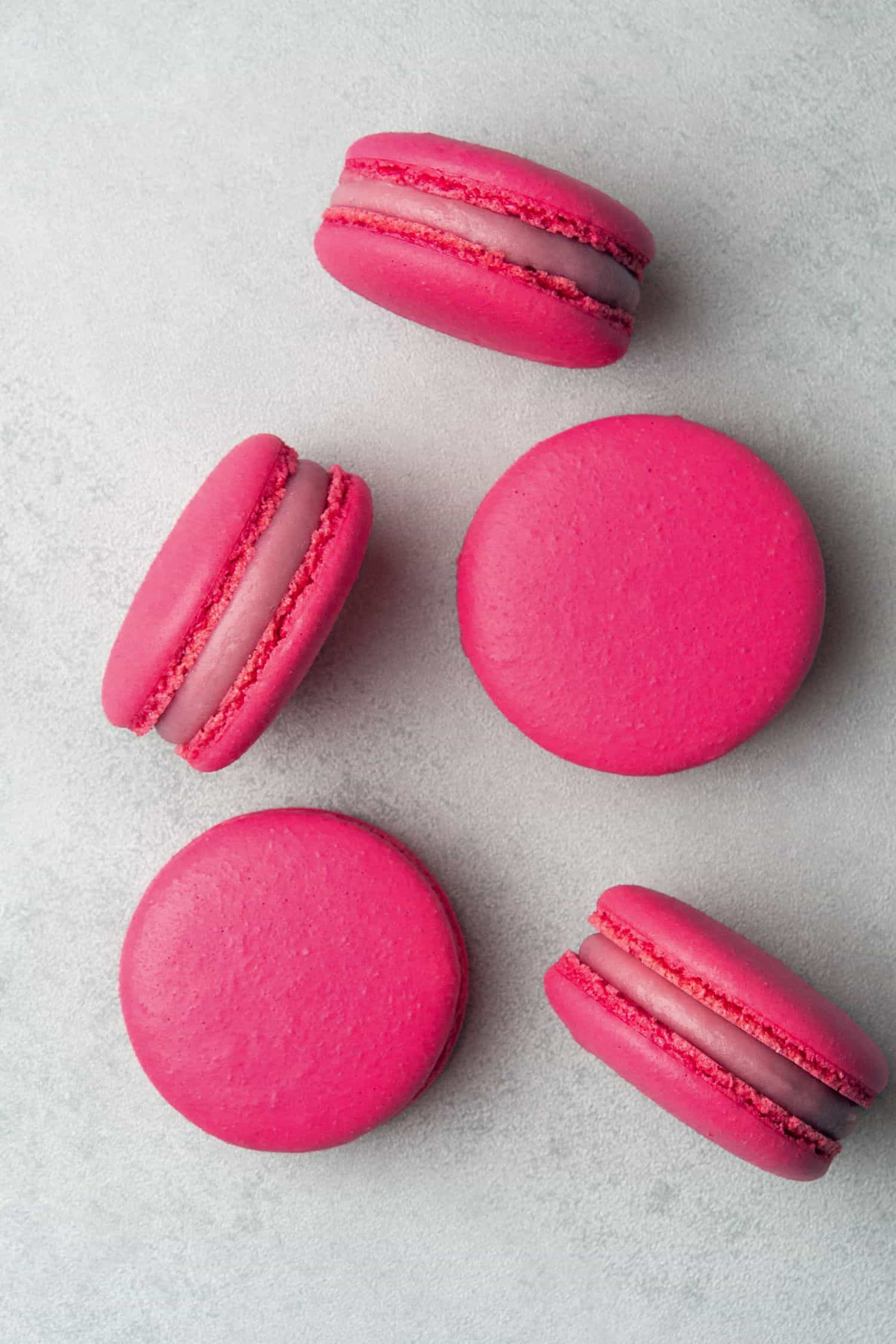
Jump to:
📖 What are macarons?
Macarons are sweet meringue-based bite-sized cookies made with egg white, sugar, almond meal, and usually food coloring. They are indeed gluten free, how cool is that!?
Since the 19th century, a typical Parisian-style macaron is presented with chocolate ganache, buttercream, or jam filling sandwiched between two cookies. The cookies are characterized by a smooth squared top, a ruffled circumference—referred to as the "feet". Macarons can be found in a wide variety of flavors that range from traditional (raspberry, chocolate) to more unusual (foie gras, truffle).
If you are wondering how to make French macarons, you are at the right place! I have tried the world´s best macarons from Pierre Herme to Laduree, and feel super passionate to teach you how to make these bite-sized desserts!
If you love French desserts, make sure to check out my ultimate best French pastries list with recipes!
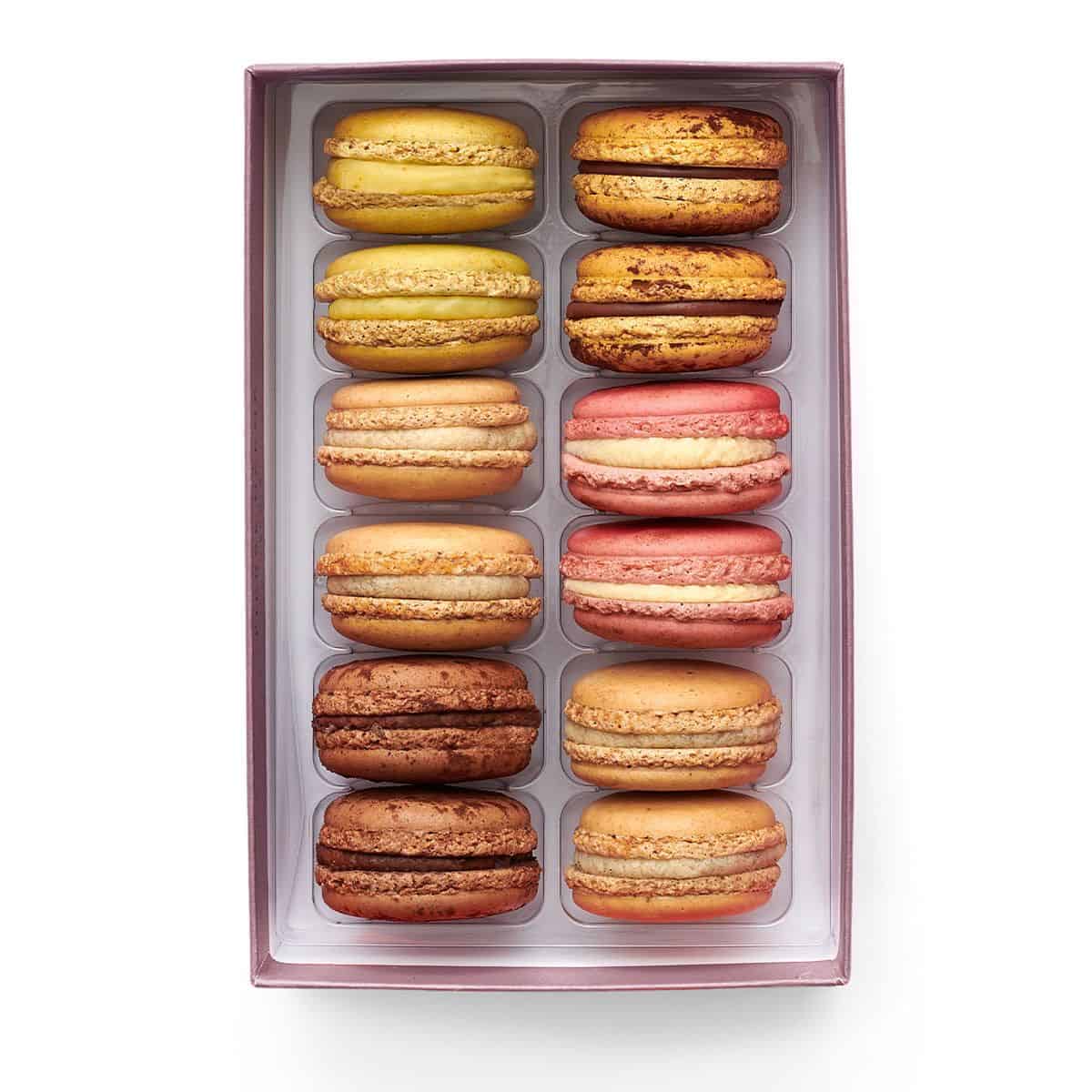
💡 What is the difference between macarons and macaroons?
Macarons and macaroons are wildly different and don´t be one of those people who confuse them!
Macaroons are made from shredded coconut held together by egg whites and granulated sugar, sometimes dipped into chocolate. They are extremely quick and easy to make, check out this macaroon recipe made by my friend, Lana.
Macarons on the other hand typically made from almond flour, powdered sugar, and egg white. Macaron cookies are very different from macaroons in terms of the preparation process but also in regards to the final outcome, texture, and taste.
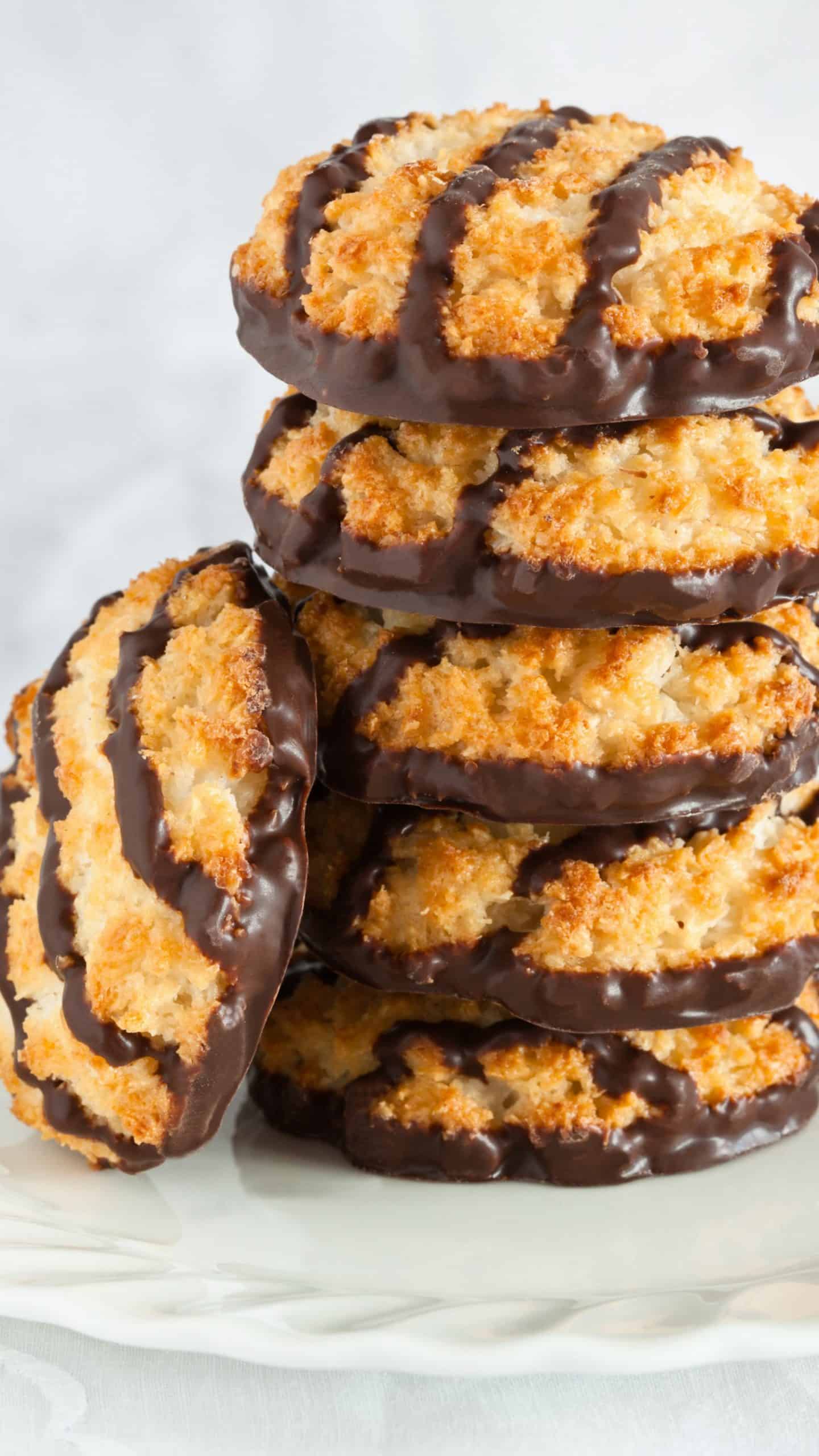
💪 How hard it is to make French macarons
In summary, they are not the easiest to make! Are they impossible to make at home? Absolutely not! You definitely have to try this macaron recipe paying attention to the hundreds of tips I am giving away!
Macaron making requires precision, patience and I would also say passion that will keep you going to practice and test the macaron recipe until you succeed. We, food bloggers, love to claim that a recipe is foolproof but if I want to be honest with you, there is no such thing as a foolproof macaron recipe or a recipe that works for all. The exact same recipe can turn out widely different just by changing something as little as a few more folds than necessary on the macaron batter - it will turn out too runny and that batch of macaron might end up like a pancake.
Although macaron is made of a few basic ingredients like almond meal, egg white, and sugar, there are a number of techniques and basic rules you have to be aware of and test in your own home kitchen environment considering humidity, your oven, how fresh the egg white is, etc.
So, when it comes to foolproof macaron recipes, and claiming that this is the best macaron recipe, I believe it is more about sharing all the knowledge, dos & don´t-s so that you will be able to walk on your own macaron-making journey with confidence until you succeed.
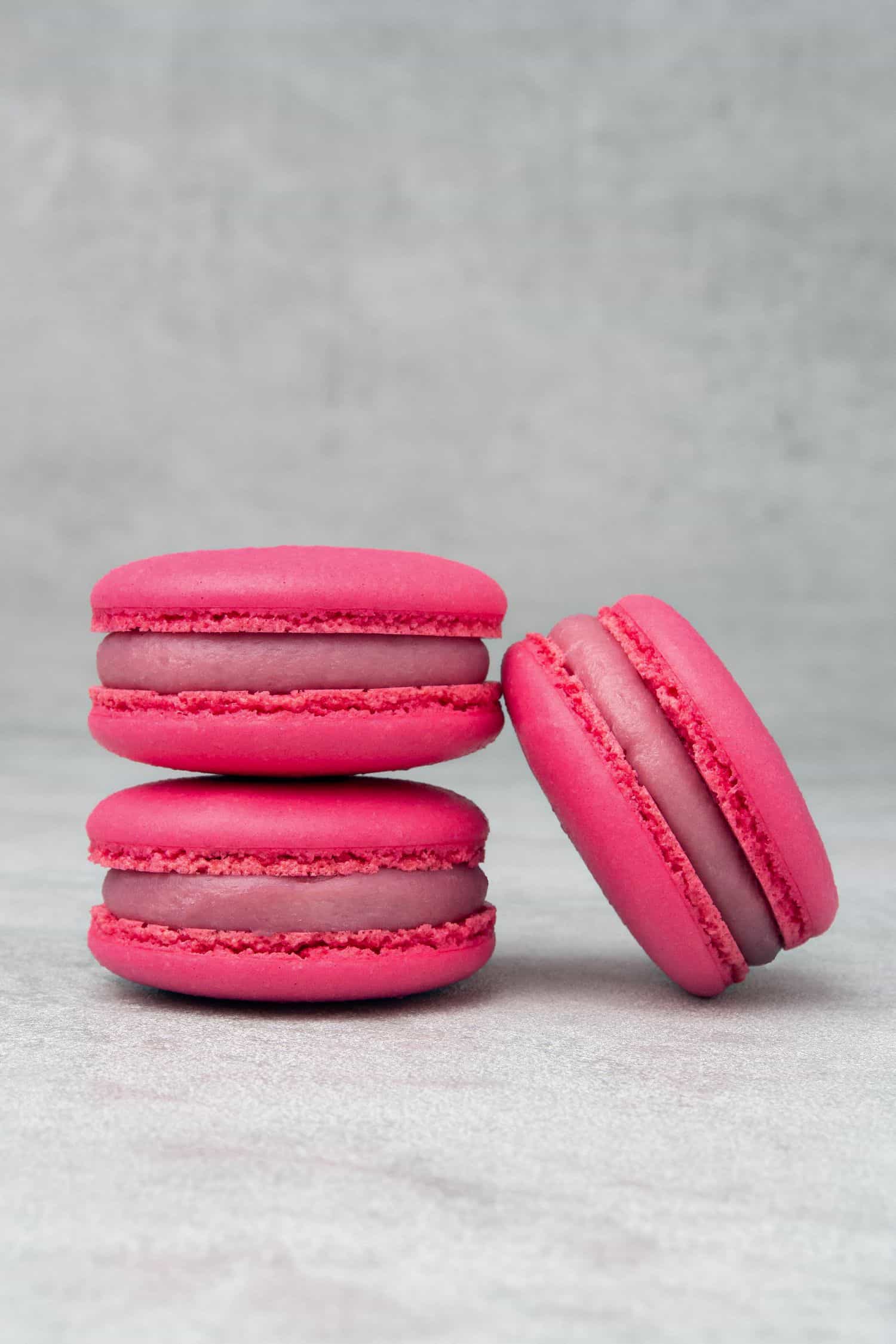
📝 Ingredient notes
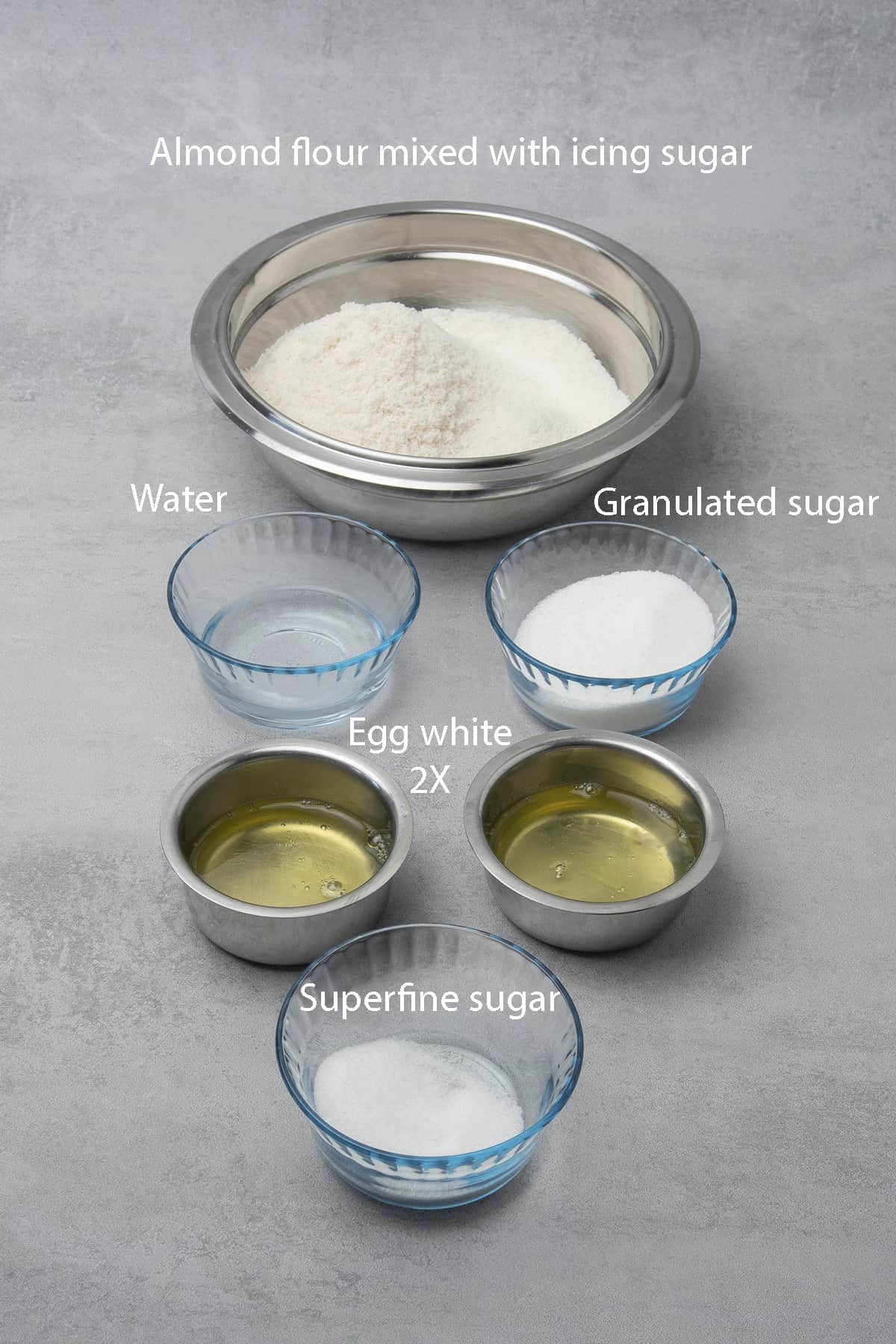
Fine almond flour
Almond is the base of this macaron recipe. Look for fine almond flour or almond meal or finely ground almonds. Worth buying good quality ground almonds so-called blanched almonds without skin. Blanched almond basically means that the brown skin has been removed. For this French macarons recipe, you always want to use blanched almond flour.
Technically you can also make fine ground almond yourself in a food processor, however, you have to be extra careful to process the almond until it is fine BUT make sure that you do not over-process it until the point that the almond starts releasing oil. While processing any nut after a while it starts to get sticky then oily then eventually you end up with an oily cream eg. almond paste that is super for making ganache or ice cream but not for making macaron. It is best if you buy ready-made fine ground almonds.
I have also heard from some of my Readers that sometimes almond powder is sold in a sort of fat-free version, I am not sure what it means exactly but make sure you buy fine almond flour so not the strange fat-free version
How to make macarons without almond flour? In fact, pistachio, hazelnut, as well as walnut flour, can make wonderful macarons! This Gold macaron recipe for example made with hazelnut flour!
Can I use regular flour for making macarons? The short answer is no! The longer answer is that recently I have seen some people making macarons with regular flour but it has a totally different texture and taste and not 1:1 substitute. Honestly, I would not even call it macaron, more like bite-sized cookies.
Sugar
For the best result I recommend using 3 types of sugar at 3 different stages of this macaron recipe
- For the marzipan-like almond paste base you will need icing sugar / powdered sugar / confectioners sugar mixed with fine almond flour. Icing sugar is effectively granulated sugar grounded into powder that typically also contains corn starch. If in your country icing sugar is not available, you can either use regular powder sugar or make your own icing sugar by mixing powder sugar with corn starch. Normally icing sugar contains 2% starch so you can mix 98g powder sugar with 2g starch to get 100g icing sugar
- For supporting the meringue; the egg white while whipping it up I recommend using fine sugar, that is normal granulated sugar pulse blended into smaller bits (but not going that far that it would turn into powdered sugar). Fine sugar is a common type to make meringue, however, if you are experienced in making meringue you might be ok using normal granulated sugar
- For the sugar syrup normal granulated sugar is totally fine
Egg white
Making this macaron recipe like any other meringue-based recipe requires egg white! Make sure you use room temperature egg whites that are absolutely free from any sort of fat (e.g. egg yolk). If you get some egg yolk into the egg white, start again. Believe me, you can’t make a successful meringue and macaron with that batch, unfortunately.
What Are Aged Egg Whites? Aged egg whites are separated at least a day ahead of time to help relax the proteins inside the whites. It helps create a strong meringue with stiff peaks. There is a huge debate about whether to use aged egg white to make macarons and if so how many days should we age the egg white. You will be pleased to know that this macaron recipe works without aged egg whites. Having said that, I don´t think that aging egg white can hurt, so it is something you can experiment with.
Food coloring
It is not absolutely necessary but macarons are meant to be colorful, aren´t they? As a general rule, you want to add a little “extra things” to the macaron recipe as possible to avoid breaking it, especially if you are just starting out. This is especially important when it comes to liquid ingredients so forget cheap supermarket food colorings!
Gel food coloring can work fine if you don’t use an extensive amount however high-quality powder food coloring is the most risk-free option. The depth of color you can achieve with any food coloring is usually in line with the quality/price. For example, it is much easier to achieve a pastel pink than dark red. High-quality food coloring does not fade while baking, check the reviews on Amazon before you purchase any product.
🛒 You’ll find detailed measurements for all Ingredients in the printable version of the Recipe Card at the bottom of this post
👩🍳 How to make this recipe
1. Which macaron method is the best
Aka What is the difference between French and Italian macarons?
Generally, there are two main ways of making macarons, the French and the Italian way defined by the type of meringue technique used in the macaron recipe. To be clear, both of them are so-called French macarons but the way how the meringue is prepared is different.
In the French method, egg white is whipped while fine sugar is added to it gradually until stiff peaks. From there, sifted ground almonds and powdered sugar are folded in slowly until the desired consistency is reached. This process of knocking out air and folding is called macaronage.
The Italian method involves whisking the egg whites with a hot sugar syrup (at a set temperature) to form the meringue. Sifted almonds and icing sugar are also mixed with raw egg whites to form a paste. The meringue and almond paste are then mixed together then, again this is called macaronage.
Either the French or Italian meringue method can make great macarons overall, however, there are a few differences. Some people might say that the French method is easier as no sugar syrup is involved, however, when it comes to overall success, Italian seems more stable, and allows fewer errors as the meringue made with sugar syrup is more stable therefore the macaronage process is way easier.
People have been long debating which one is easier and/or tastier, I suggest starting with this macaron recipe below that offers the least opportunities for mistakes.
💡 Top Tip: The macaron recipe below is following the Italian meringue method however some part of the sugar is added into the meringue in a "French way", before pouring the sugar syrup in, I find it is more foolproof and helped a lot of my Readers to finally achieve the desired results.
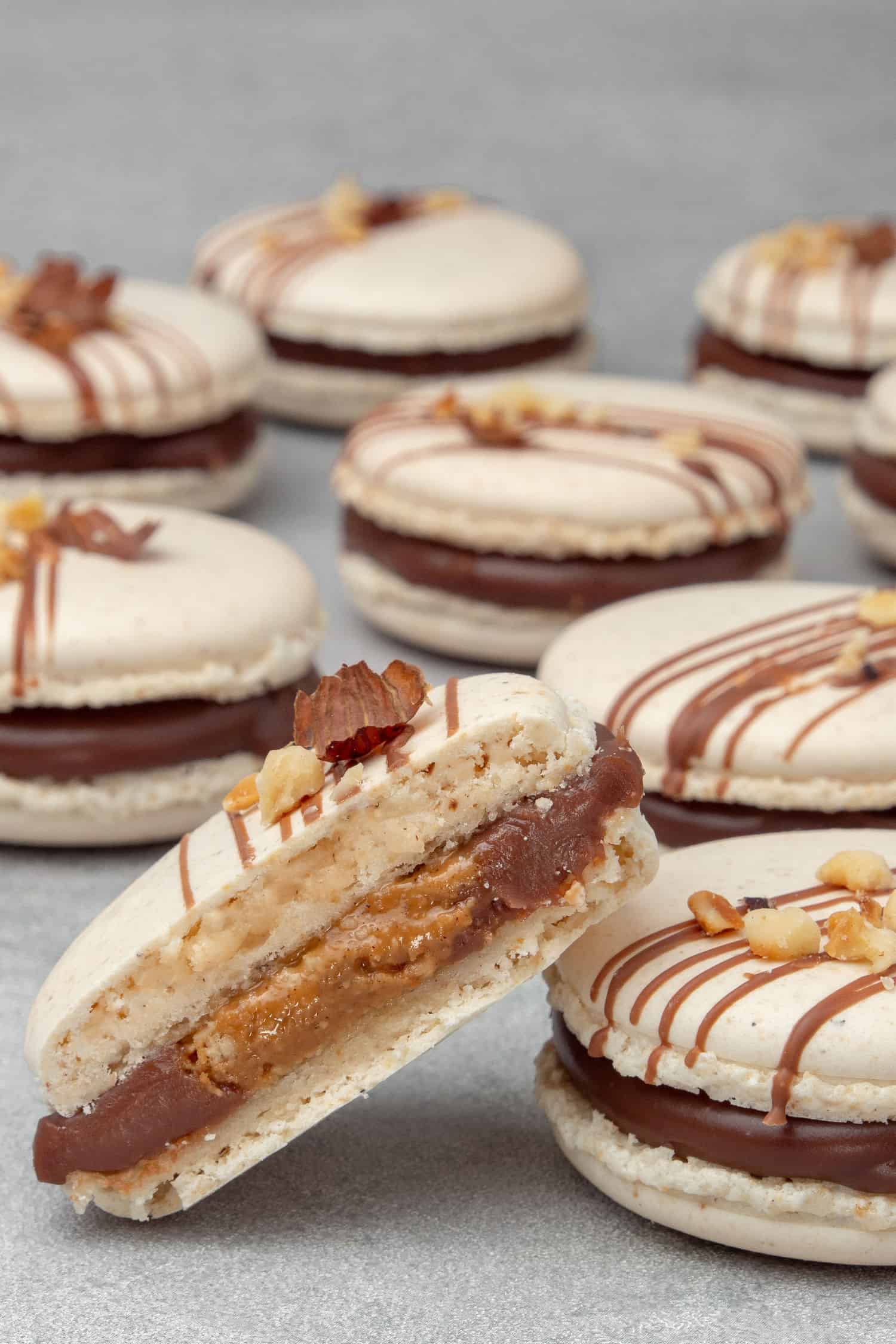
2. What food coloring is the best for making macarons
Good quality food coloring should not fade while baking and should not mess up the texture of your meringue so make sure, you chose a reputable brand, perhaps check Amazon reviews.
I recommend powder food colorings, they make no impact on the texture of the meringue whatsoever., super safe to use and the one I have certainly does not fade at all. I do not have a link for the one I use (bought it in France many years ago), but I have the picture of it. It is a brand called Les Artistes-Paris.
Alternatively, as the second-best option, go for concentrated gel food colorings, any reliable brand like Wilton or AmeriColor should work. Always start with a small amount and increase it gradually. If you are making macarons the first time, it is a good idea to skip food colorings for two reasons: 1. One less risk 2. You will be able to judge the color of your baked macarons better eg. is your macaron browning?
In terms of natural food colorings, I have not tested much myself apart from matcha. The problem with natural food colorings, in my view, is that you have to add so much that it might destroy the meringue. Remember, until you are a real Pro, it is always a risk to add anything to the macaron batter so take it step by step.
💡 Top Tip: Forget liquid food colorings, it will mess up the macaron batter and very likely your macarons will crack.
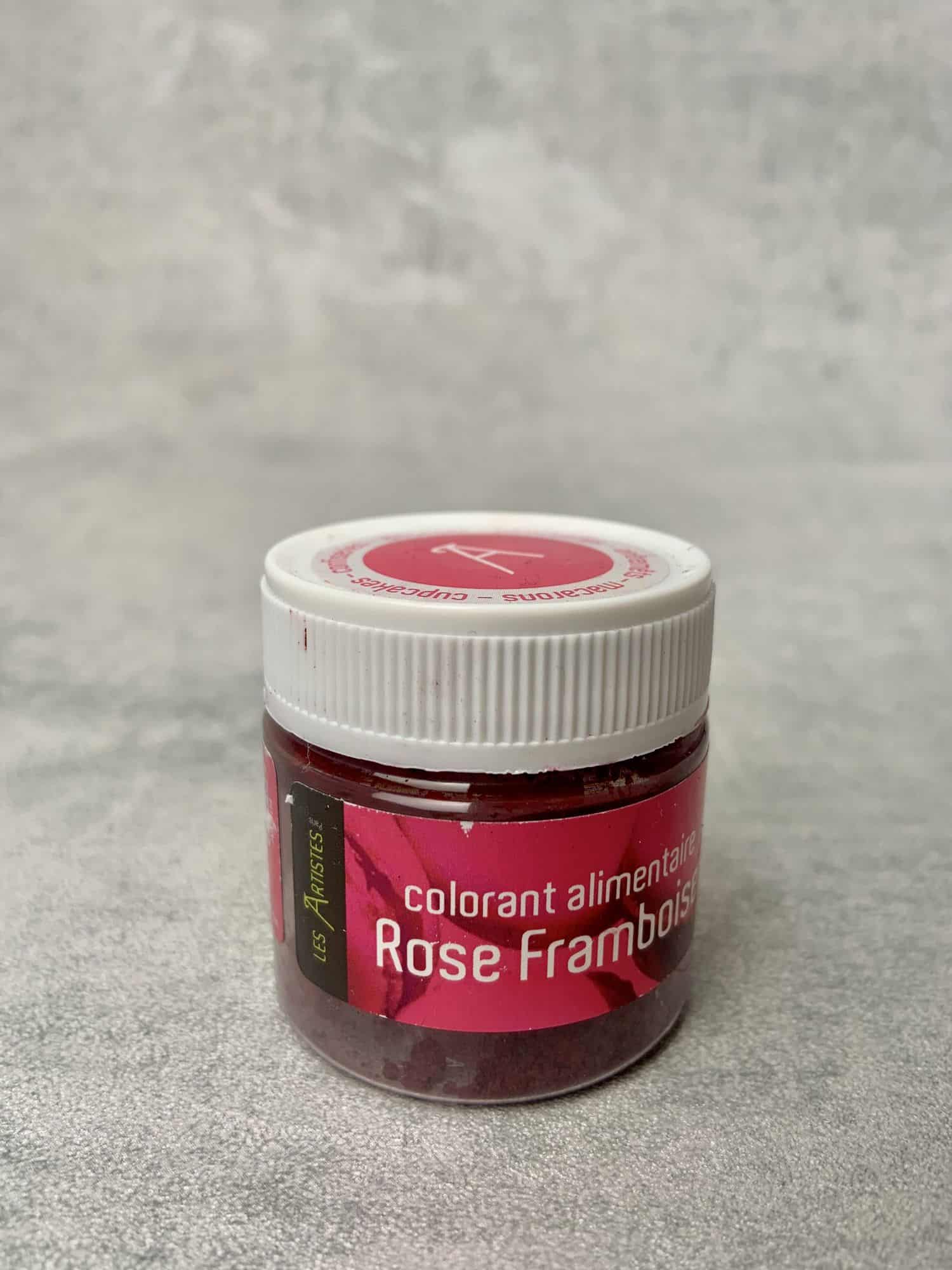
3. Step-by-step process of making macarons - Italian meringue technique
Disclaimer: Macaron is typically a dessert that most people have to try more than once to get it right. Do not expect that they turn out perfect the first time! The ones you see on Instagram or Pastry shops usually have been perfected many many times sometimes over years! I have a Troubleshooting Guide at the end that will make your macaron journey easier so you can fine-tune your technique, ingredients, baking temp until you get it right! Enjoy the ride!
As mentioned above this macaron recipe is based on the Italian meringue method. Once you start making macarons you will realize that although the whole process looks like 20+ steps here, in reality, it is literally less than 15 minutes.
The technique part is where you need a good foundation so it is worth spending a bit of time learning sort of the "theory part" before you make your first batch in practice.
Regarding the quantity of this macaron recipe, it makes about two trays of macaron shells (approx. 22-25 macarons) depending on the size and how closely you pipe them next to each other.
- First and foremost before starting this macaron recipe you have to measure all your ingredients with a Digital scale. This is non-negotiable, you absolutely can not make macarons using cups, it is simply inaccurate. It might work for simpler cookies (not really), but definitely not for macarons
- Arrange every tool you will need at hand, there is nothing more stressful than not finding the piping bag when you need it. You will need the following items: Rubber spatula, Stand mixer with a whisk attachment, Infrared thermometer gun or any other cheaper thermometer to measure the sugar syrup, Piping bag with a round nozzle tip eg. 1A Round nozzle tip, Silicone baking mat, or a tray with parchment paper, Digital oven thermometer to check your REAL oven temperature. Prepare also the food coloring next to the mixer
- Wipe down the mixing bowl and whisk attachment with vinegar to remove any potential residue
- Pulse blend the dry ingredients; almond flour with confectioners sugar for 5-10 seconds (no longer as the almond can get sticky/oily ), then sift them together and measure with a Digital scale
- Make sure egg white is at room temperature, you will need 2 x 55g
- Move one of the 55g egg white into the mixing bowl of your Stand mixer
- Prepare and measure the superfine sugar and have it close by the Stand mixer
- Start making the sugar syrup by boiling granulated sugar with water in a saucepan
- Start whisking egg white on low/medium, once foamy, start adding the superfine sugar slowly, a small amount at a time
- Boil sugar & water together for a few minutes until reaches 118C-120C / 244-248F. On my powerful stove, this takes about 3 minutes. You absolutely have to measure the correct temperature either with a Infrared thermometer gun or any cheap sugar thermometer. One tricky part is how to measure the syrup temp in a shallow saucepan so make sure you use a small saucepan that actually can give some height to the syrup, which is easier to measure. If you use a large saucepan, the syrup "will get lost" in the saucepan making it impossible to measure the correct temp
- By the time syrup reaches 118C-120C / 244-248F, the egg white & fine sugar mixture should be already reaching consistency of somewhere between foamy and soft peak. If the egg whites are at soft peaks before the syrup reaches the desired temperature, turn the mixer down to low speed to keep the egg whites moving but do not whip it up to stiff peaks
- Once the syrup is on the right temp (118C-120C / 244-248F), remove from heat, wait 5 -10 seconds for the bubbles to calm (be careful!!)
- Increase mixer speed to medium and begin slowly pouring the sugar syrup down the side of your mixing bowl into the meringue until thoroughly combined. Pour it slowly but constantly. This is one of the tricky parts of the process. What you want to make sure is that you pour the syrup without touching the whisker as that would result in making a whole lot of mess within the mixing bowl including sugar syrup crystallizing into hard sugar shards. Make sure you pour the syrup on the side of your bowl and it will be fine.
- Increase the mixer speed to medium/high and continue beating the egg white until it develops shiny, sticky, stiff peaks and as you touch the bowl it is more or less cooled. In my experience, you do not need extra hard meringue as some other recipes state. I only beat the meringue for 3-4 minutes, by that time it is already stable and fluffy but check the consistency rather than the time
- While beating up the meringue mix the other 55g egg white with the almond flour mixture (almond meal & icing sugar). Use a flexible Rubber spatula. First, it might look crumbly but it should come together in a minute or two into a thick almond paste. This step can be done ahead if you wish, however, you have to cover it with plastic wrap as it can get dry in a few minutes
- In the meantime keep an eye on the meringue and check its consistency every now and then. When the meringue is 90% ready (judging that will come with practice) add food coloring in. As mentioned above I recommend using powder coloring that has no impact on the meringue texture. The second best option is high-quality concentrated gel food coloring. Do not use liquid food coloring as it will ruin the meringue
- Once you have your stable meringue ready as well as the marzipan paste, let´s move onto the macaronage stage of this macaron recipe
- Gently fold in meringue into the marzipan mixture in thirds, making sure that each third is fully incorporated before adding the next
- In terms of the folding process, it is quite a particular one: I like to think that the first third is about loosening up the marzipan, the second third already working on the macaronage process and somewhat pressing the air out and the last third is fine-tuning the consistency to the stage you need - that is not too runny, not too stiff, the ribbon stage
- After adding the last third of the meringue make sure you check the consistency of the macaron batter every few seconds. How to check when the macaron batter is ready? When you lift the spatula over the mixture the batter should fall slowly forming a ribbon. Try to write number 8 with the ribbon, once the consistency allows writing the number 8, it is very likely that your macaron batter is ready
- I would like to highlight that it is extremely important that you do not over mix your macaron mixture. Too much folding would result in too runny macaron batter that makes it impossible to pipe or even if you can pipe, it would spread too much.
- On the other hand, not enough folding would result in too thick macaron batter that again makes piping difficult, leaving unappealing nipples on the macaron shells. It can also result in unpleasant texture and unappealing look of the final baked product
So overall there are two crucial steps you need to get right during making this macaron recipe: a strong meringue and an appropriate macaronage = folding technique that will make the batter into a so-called ribbon consistency.
Again, it might sound difficult and a long process but in practice, this is done in less than 15 minutes!
💡 Top Tip: In theory, you can half the recipe but it is not easy to whip up half-size meringue also difficult to measure the temperature of the sugar syrup if it is a too small amount. So, I do not recommend half the macaron recipe if you are a beginner.
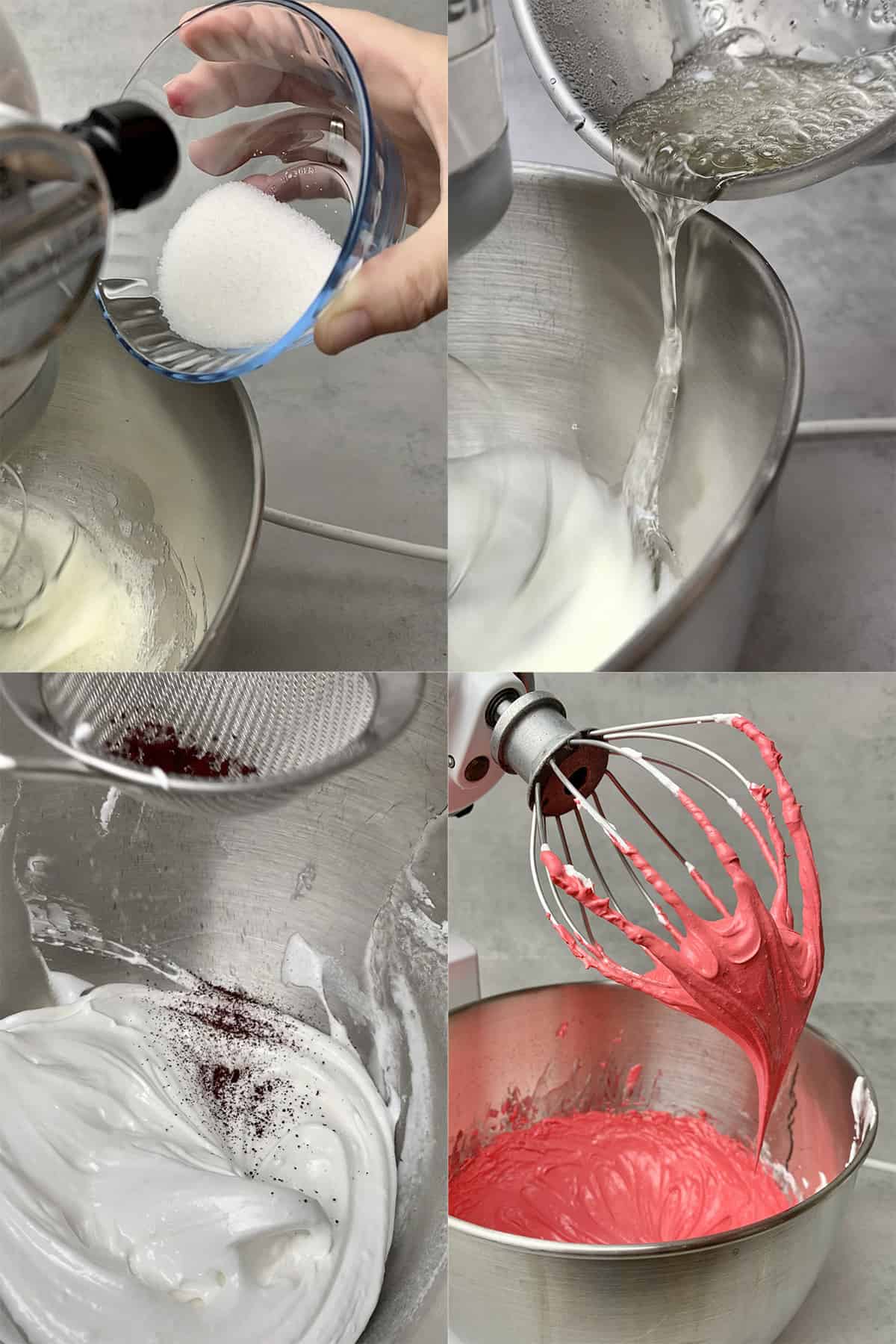
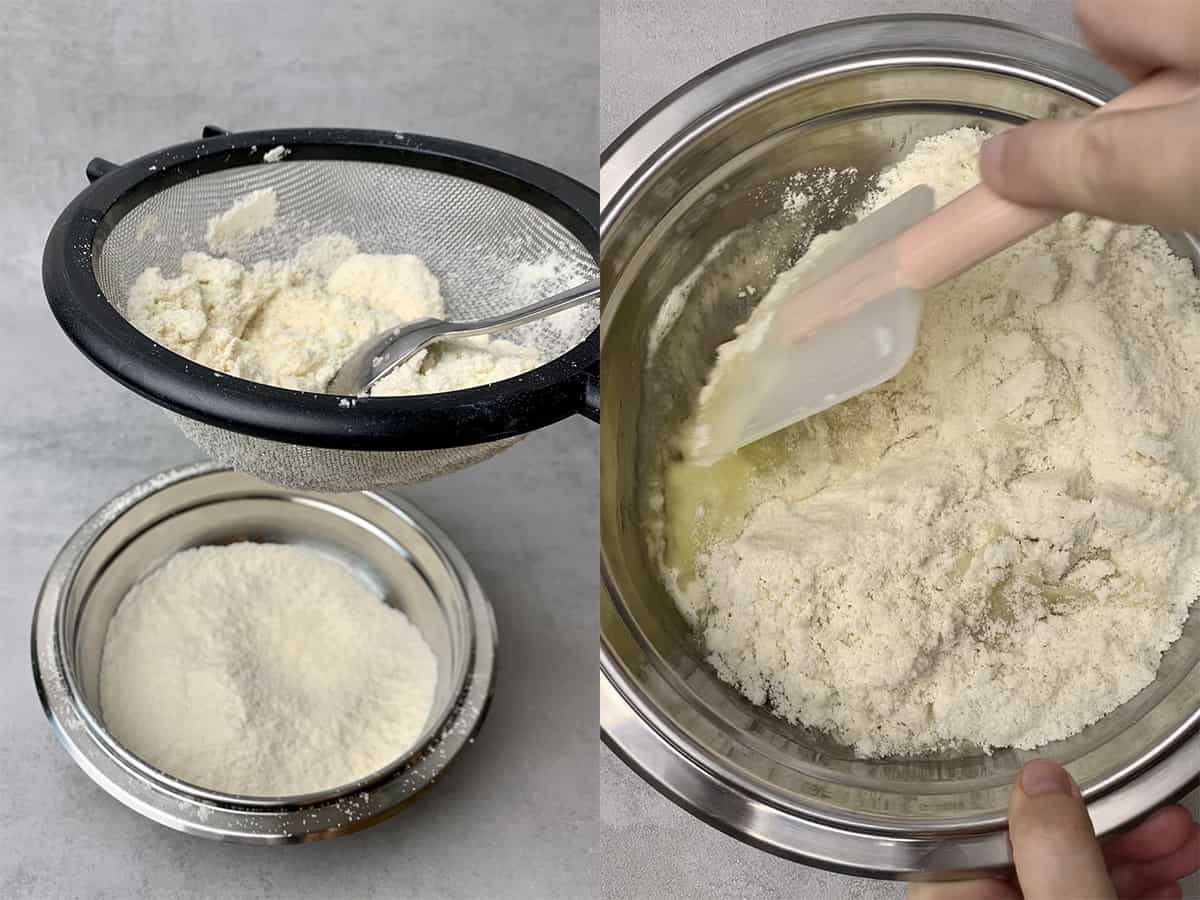
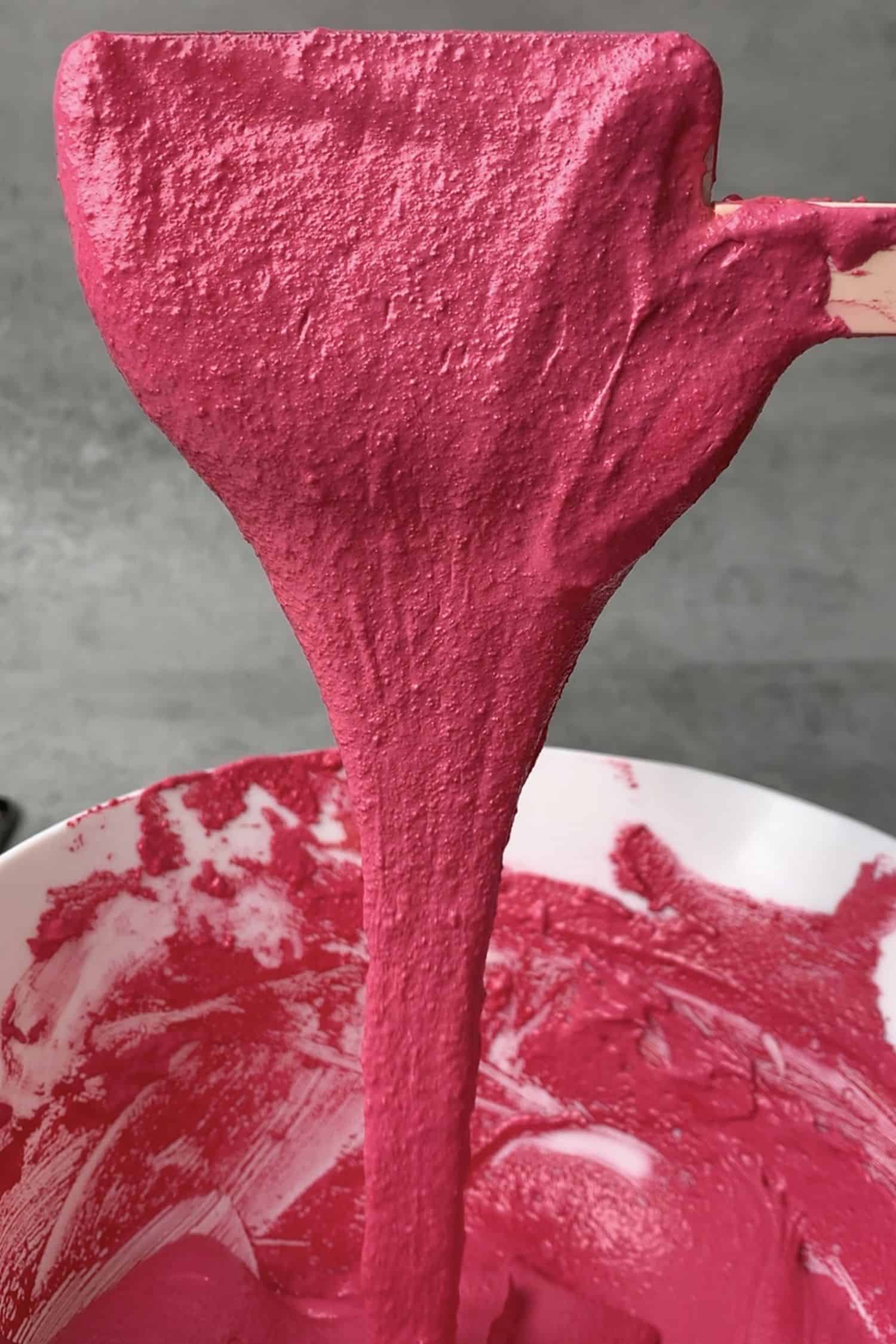
4. How to pipe macarons
Once you have your macaron batter ready in the right consistency (ribbon stage) the next task is piping, it is actually a rather important part of making macarons.
You will need a Piping bag with a round nozzle tip eg. 2A Round nozzle tip, or alternatively, you can cut the end of the piping bag but make sure you cut it straight otherwise the macarons might turn out to be egg-shaped. Piping equal-sized, round macarons takes a lot of practice, don´t be hard on yourself!
Using a template with circles can be useful, but even with that almost 100% you don´t get it right the first time and it is fine! Ideally, the size of the macaron should be around 3-4 cm (1,5inch) in diameter, but don´t stress about that the first time. However, make sure you pipe more or less equal-sized macarons on your prepared baking sheets, so you can sandwich them together later when they are baked.
You will also need a Silicone baking mats or a tray with parchment paper. Again, lot of debate about which is one is better (or a third option that many people recommend: Teflon sheet). As you can see my macarons turned out almost identical on the parchment vs Silicone baking mat so don´t worry about it too much.
If your macarons do not turn out well it is most likely due to inappropriate technique or baking temperature and not because of the baking sheet. My personal preference is Silicone baking mat over parchment because it is more sturdy, less floppy and with parchment paper, there is always the risk of getting slight wrinkles on the paper that is not the best when you want flat macarons.
OK, now onto piping the macarons!
- First of all, you should move the macaron batter into the piping bag in a careful manner, making sure to minimalize any air bubbles. Fill the piping bag maximum half, then try to remove any air bubbles before piping - by pressing onto the piping bag with your hands
- Hold the piping bag fully vertical and pipe with even pressure. Leave some space in between the macarons making sure they don´t touch each other if they spread a bit, also the air can circulate in between them while baking
- As you pipe, the macarons should spread a little but not too much - if the macaron butter is in the right consistency. In case the macarons are spreading too much, or the batter is too runny, try making another batch and fold it less
- If you are experiencing tiny nipples on top of the macarons after piping, you can get rid of them by tapping the tray onto the kitchen counter a few times (once you piped a whole tray)
- Whether there are nipples or not, tap the tray onto the kitchen counter about 5-6x to release air bubbles. Pop any air bubbles that might've come to the surface using a toothpick
- Now onto waiting. You will need to rest the macarons until proper skin has formed on the outside of the shell. There are some other macaron recipes out there with different ratios and sugar syrup temperature that requires longer or no resting time at all.
This particular macaron recipe requires a resting time of 25-40 minutes depending on temperature and humidity. Test by gently touching the macarons. I found sometimes they feel "dry" already after 10 minutes but when I baked them they still cracked so make sure they are super dry as you touch them, and there is a real thick skin on the surface.
💡 Top Tip: Not resting your macaron long enough is the most common reason for cracks on the surface while baking so I would say it is probably a good idea to wait at least 25 minutes. On the other hand, do not rest them for too long (hours) either as that can cause a whole lot of other issues
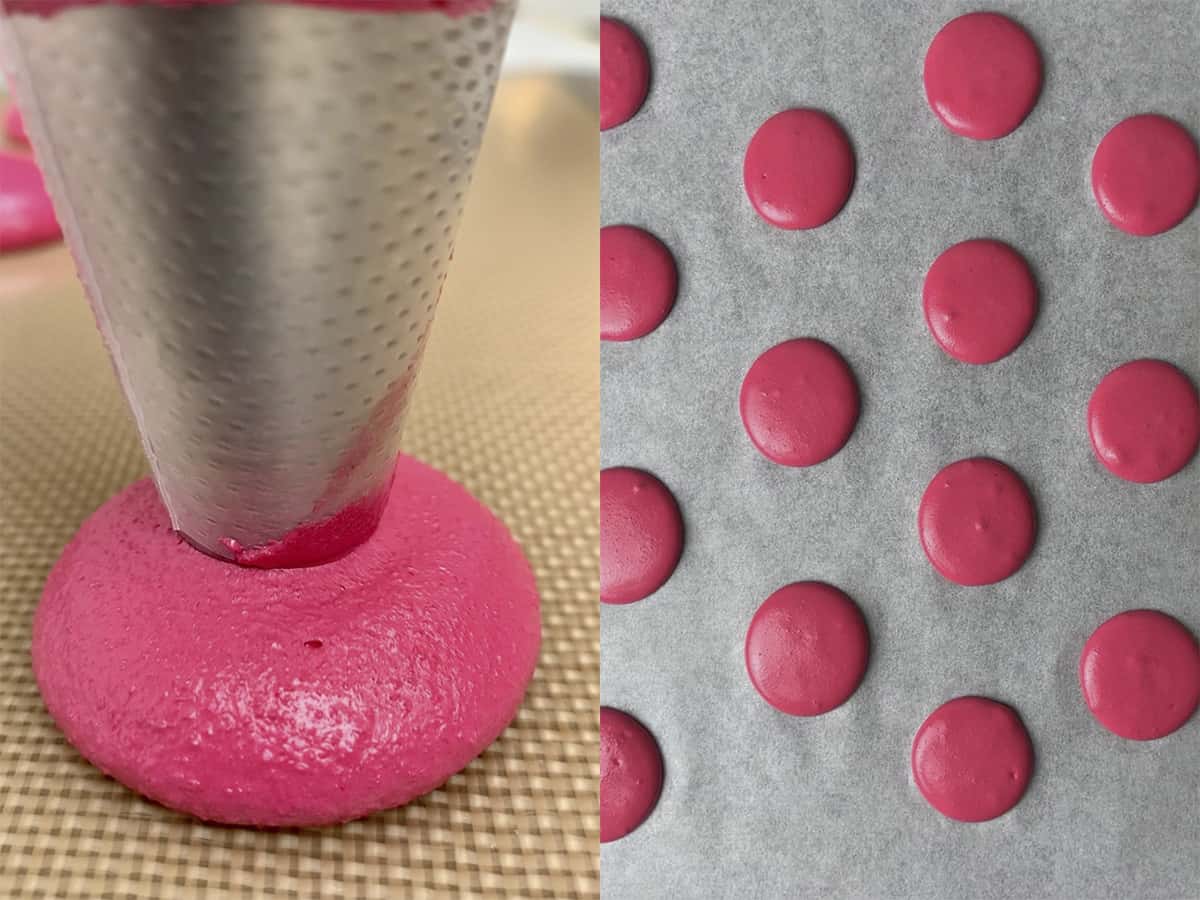
5. How to bake macarons
Once you nailed making meringue, the macaronage process, and the piping technique, the next thing is baking these amazing, delicate French desserts!
I strongly recommend investing in an inexpensive Digital oven thermometer. Most ovens are under or oven heat and with macarons, that can make or break the outcome! An oven thermometer is a must!
The bad news is that there is no such thing as one oven temp that fits all! The good news is that once you make your first 1-2 batches of this macaron recipe, you will see whether you need to increase or decrease the oven temp.
- Bake the macarons only after appropriate resting time, there should be proper skin formed on the surface of the macaron
- It is a good idea to properly pre-heat your oven while resting your macarons so for about 25 minutes
- I recommend baking the macarons 155C / 311F (no fan) but I pre-heat my oven +20C / 68F more as when I open the oven door, the temperature drops
- I bake the macarons in the bottom third of my oven so they definitely do not get browned on the top, you know your oven the best, please experiment
- I bake the macarons for 14-15 minutes, but you have to test them in your own oven. They should not get browned in this temperature but there should be a feet development already at around 5 minutes
- Once macarons are done, remove them from the oven and cool them on the parchment or silicone mat for 30 minutes. Please note, they will stick to the mat while they are hot, they are not supposed to come off until they cool!
It is down to personal preference, either way, your macarons should turn out well with this recipe
When you touch the top of the macaron, it should not move around on its feet. If it does, then they are not yet done baking. However, do not test whether they easily come off the baking sheet because they are not supposed to! They will only come off the baking sheet (whether it is parchment or silicone) when they are cooled!
I suggest do not open the oven door unless your oven bakes very unevenly. How do you know that your oven bakes unevenly? Well, you will see it on the macarons, they don´t lie! If some part would be browning or it would be an uneven feet development on the macaron shells, it might be a good idea to quickly rotate the baking sheet.
You might see no feet development or that they need significantly more time in the oven to be done. Increase the oven temp by 5C / 50F next time
Too high baking temp can cause the macarons to sort of explore or bake in a "mushroom" shape or even crack on the top (a lot of other things can cause cracks too). Or perhaps they will be browning...Decrease the oven temp by 5C / 50F next time
💡 Top Tip: I do not recommend using a fan unless it is a professional oven that you have. In home ovens, the air can circulate all over the place which can cause a lot of issues with the meringue.
6. How to neatly fill macarons
Finally, you nailed this macaron recipe, it is time to fill your macarons!
First, prepare the filling and let it set in the fridge - depending on the recipe it might take a few hours or overnight.
Once you have the macarons shells baked and cooled, you are safe to remove them from the baking sheet. In case they ended up slightly different in their sizes (that happens, don´t worry), make sure you pair the similar sizes of macaron shells next to each other.
For filling the macarons you will need Piping bag with a round nozzle tip (2A Round nozzle tip)
Filling macarons takes again some practice. The general rule is to pipe the filling onto one side of the macaron then press two shells together evenly so the filling will come out to the side but not more. How much filling do you need per macaron? It is impossible to give an exact amount here, you will see after filling one or two macarons whether you need more or less.
💡 Top Tip: Macarons require about 12h aging time in the fridge (depending on the filling), within this time frame the filling will soften the shells. They can be eaten of course straight away but the texture will be rather hard, nothing like the beloved soft and chewy macaron texture.
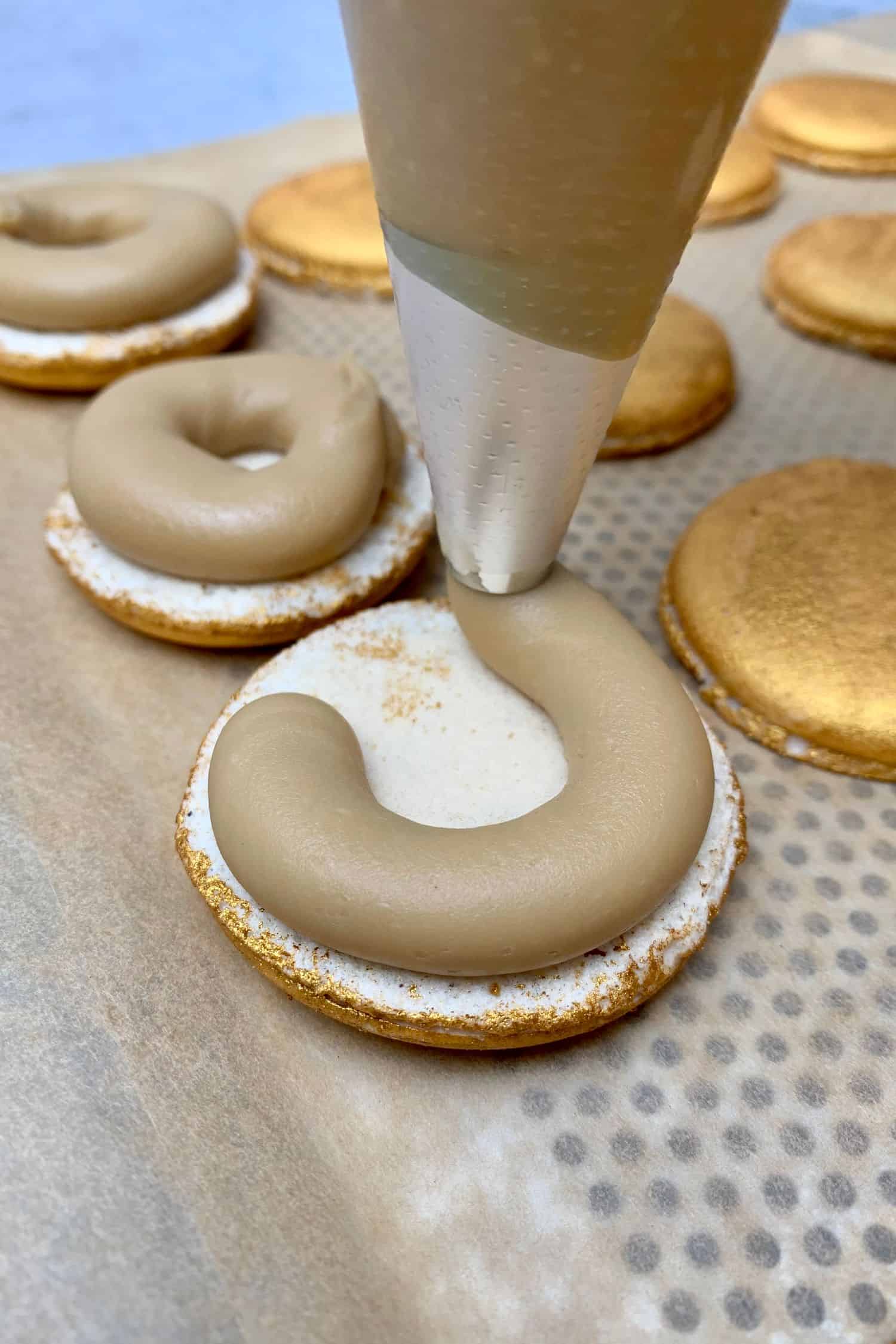
7. How to store
Macarons are normally stored in the fridge in an air-tight container and their shelf life is rather a delicate matter.
Once they are filled, they need about 12h in the fridge for the shells to soften however over time they will further soften and can become mushy. My recommendation is to make the macarons a day ahead so if you want to serve them on a Saturday afternoon tea, assemble them on Friday and they will have the perfect texture for Saturday.
Macarons can be also frozen before and after filling too, I don´t tend to do it but if you are making them in a large batch, it might be a good idea. (depending on filling)
✨ Filling ideas
I love that Macarons are super versatile, you can literally make any fillings from raspberry to pistachio or more extreme ones like blue cheese or truffle. Typical macaron fillings can be white, milk, or dark chocolate-based ganache, fruit curds, perhaps fruit confit, or jam. I do not prefer buttercreams, see the reasons below
There are a few considerations worth bearing in mind regarding macaron fillings:
- The macaron shells are naturally sweet due to the sugar syrup and icing sugar therefore I do not recommend overly sweet fillings that are full of sugar eg. buttercream
- Macarons are stored in the fridge and "aged" for around 12 hours therefore you have to think about a filling consistency and texture that is pleasantly smooth yet firm enough at fridge temperature, again a silky chocolate ganache is a much better choice than buttercream that can get rock hard in the fridge
I particularly enjoy tangy fillings in macarons, eg. lemon curd in my Earl Grey Lemon macaron
Nut based chocolate ganache eg. pistachio ganache can be another fantastic idea, eg. my Pistachio macaron
One of my favorites is the caramelized white chocolate ganache I filled my Gold macaron
You can also combine chocolate ganache with nut paste, eg. hazelnut paste as in my Chocolate & hazelnut macaron
My other recommendation is fruit ganache eg. white chocolate-based raspberry ganache that brings silkiness and natural fruitiness to the filling. In my tarts eg. in this raspberry tart recipe I use a 1:1 ratio so 200g chocolate with 100g heavy cream and 100g fruit puree. For macaron filling the ganache needs to be a bit more thick and stable so I used 200g chocolate with 75g cream and 75g fruit puree to fill my macarons in this post.
Coffee ganache can be also a perfect macaron filling with natural, delicious coffee flavor. In my coffee tart recipe I use a 1:1 ratio so 200g chocolate with 150g heavy cream and 50g coffee. For macaron filling the ganache needs to be a bit more thick and stable so use 200g chocolate with 80g cream and 20g coffee.
Finally, pastry cream is used to fill my Crème brûlée macaron. Please note that pastry cream is wetter vs. chocolate ganache and the resting process is different from the usual one, I have instructions on that in my recipe.
🥣 Equipment notes
This macaron recipe is relatively a low-key activity in terms of equipment, you really don´t need a lot of fancy tools - instead, it is more about precision and practice.
Ideally, you will need the following items for making this macaron recipe:
Digital scale - For a consistent, happy baking experience always measure your ingredients. This is absolutely a MUST
Rubber spatula - Every home baker needs a few good quality rubber spatulas, not just for this macaron recipe but for every dessert where the recipe states "folding"
Stand mixer - Macaron making is a multitasking process and a stand mixer will make your life easier while beating the meringue. I did make macarons a few years ago with an electric hand mixer but it is about 1000 times easier and less risky with a stand mixer. I have a KitchenAid Classic and that works perfectly fine
Infrared thermometer gun or any other thermometer - Once you progress in your baking journey at some point you will need some thermometer to measure sugar syrup or any other ingredients that need to be at a certain temperature. You can buy it as cheap as a few euros/dollars or you can purchase a more advanced Infrared thermometer gun that is a must to use for chocolate tempering
Piping bag with a round nozzle tip eg. 2A Round nozzle tip - Nozzle tip is not mandatory in case you can cut your piping bag perfectly straight and pipe the macarons directly without nozzle, however, a piping bag is absolutely necessary to make macarons. I must state that no matter what piping bag you chose to purchase, practicing your piping technique is also a must. If you have never used a piping bag before, perhaps it is a good idea to make any kind of cheap buttercream and practice first
Silicone baking mat, or a tray with parchment paper - I warmly recommend investing in 2-3 pieces, I use it all the time in other recipes too. If it is not accessible for you, use parchment paper, it should still work for this macaron recipe!
Digital oven thermometer to check your REAL oven temperature - I would say this is non-negotiable. So many of you messaged me with various baking problems in the past year and at least half of these issues can be contributed to inappropriate baking temp. In the case of making macarons, baking temp is one of the most important factors, and being aware of your real oven temp is as important as measuring your ingredients properly
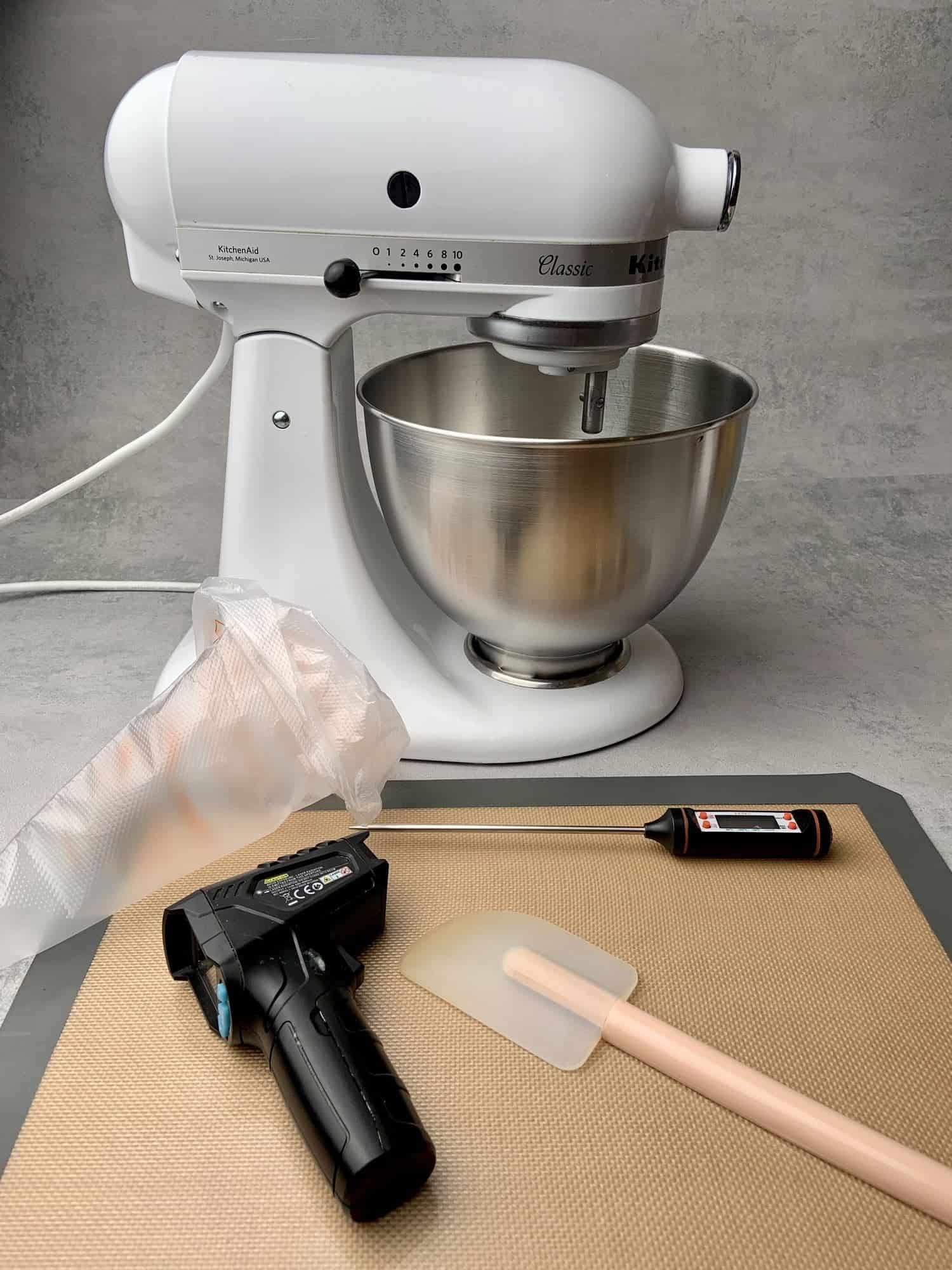
🎓 Macaron Troubleshooting Guide
Macaron baking is one of a kind, you either succeed relatively quickly or you might run into several issues. I suggest first familiarizing yourself with this macaron recipe including the "theory part" then jump into practice, test, and learn from your mistakes. There is no such thing as impossible in baking, if I could make it, you can make it too with practice and precision!
Sometimes one issue can be caused by various mistakes eg. oily almond flour, inappropriate folding technique, and too high oven temp combined.... so you have to test and learn, change and adjust.
I put together a Macaron Troubleshooting Guide section in here, as you might recognize some of these mistakes and with the help of my Troubleshooting, you will learn how to avoid them. I made some of the mistakes on purpose, some of them by accident, also got some pictures from you guys.
1. Macarons have vulcanic eruption/cracks on the top
Possible causes & Solutions
- not resting long enough before baking - Solution: I actually made this mistake on purpose to show you what happens if you bake the macarons straight after piping without appropriate resting time. With this macaron recipe (there are some others out there with different ratios), make sure you rest the macarons until proper skin has formed on the shells, this can take anywhere between 25-40 minutes depending on temperature and humidity. Test by gently touching the macarons. I found sometimes they feel "dry" already after 10 minutes but when I baked them it was still too early so make sure they are super dry as you touch and there is a real thick skin on the surface
- too much air or air bubbles in the macaron batter - Solution: make sure you tap the tray a few times onto the kitchen counter after piping
- too high oven temp so the macarons effectively erupt- Solution: try decreasing oven temperature 5C/50F less next time
- too much liquid in the meringue - Solution: Several years ago I had many cracks on my macarons then I realized that cheap supermarket kind liquid food coloring is not appropriate to make macarons. Using concentrated gels or powder is even safer. If you are constantly struggling with cracks, try baking one batch without food coloring and see how they come out
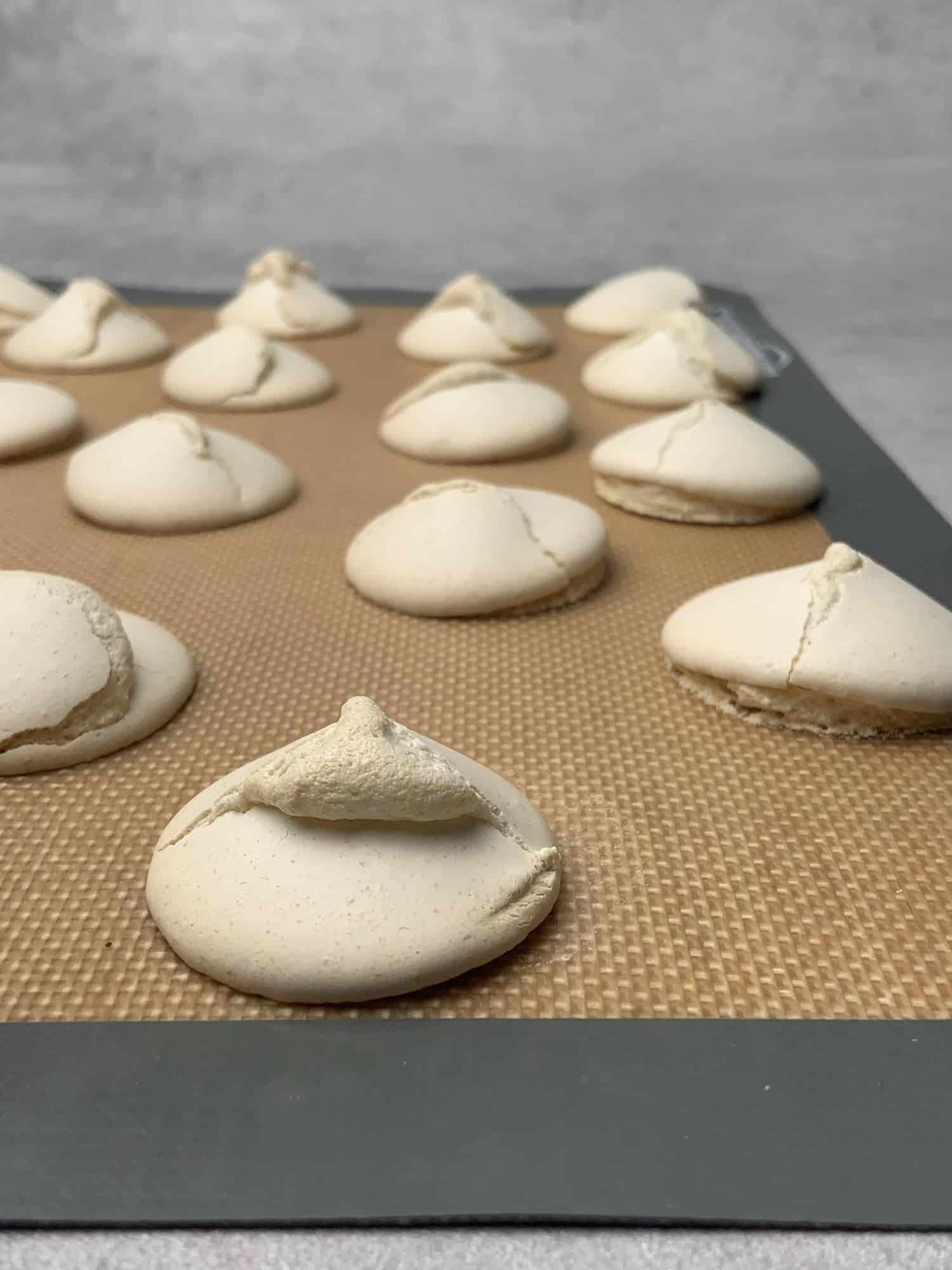
2. Macarons are lopsided
Possible causes & Solutions
- resting too long - Solution: I made this mistake on purpose as wanted to check what happens if I rest my macarons for over an hour. Make sure you rest the macarons until proper skin has formed on the shells but not too long so do not leave them without baking for hours
- uneven piping - Solution: Make sure you pipe the macarons straight while holding the piping bag perfectly vertical
- too strong or uneven fan in the oven / uneven heat in the oven - Solution: I do not recommend using a fan if you have an average home oven as the air can circulate very unevenly, therefore, macarons bake unevenly. What if you don´t use the fan and your oven still heats unevenly? Unfortunately, it is a very difficult situation and apart from rotating your tray (that has also risks - see below) there is not much you can do
- opening the oven door - Solution: You have to remember that macarons are very sensitive meringue-like cookies, therefore, opening the oven door and letting cold air in is not the best idea. However, if your oven heats very uneven, feel free to rotate the tray halfway through but make sure you do it as quickly as possible
- tapping the baking tray too hard or uneven - Solution: Tapping the baking tray is important but make sure you do not ruin your macarons while doing so. It is especially risky when macarons are piped onto parchment paper that is not as sturdy as silicone baking mat

3. Macarons stuck to the baking mat
Possible causes & Solutions
- underbaked - Solution: This is actually a really easy issue to fix. If your macarons are stuck to the baking mat it is almost sure that they are underbaked. Next time bake it a few minutes longer
- macarons are still warm - Solution: Please remember that you have to let the macaron properly cool on the baking mat before moving them. They are not supposed to come off while they are hot
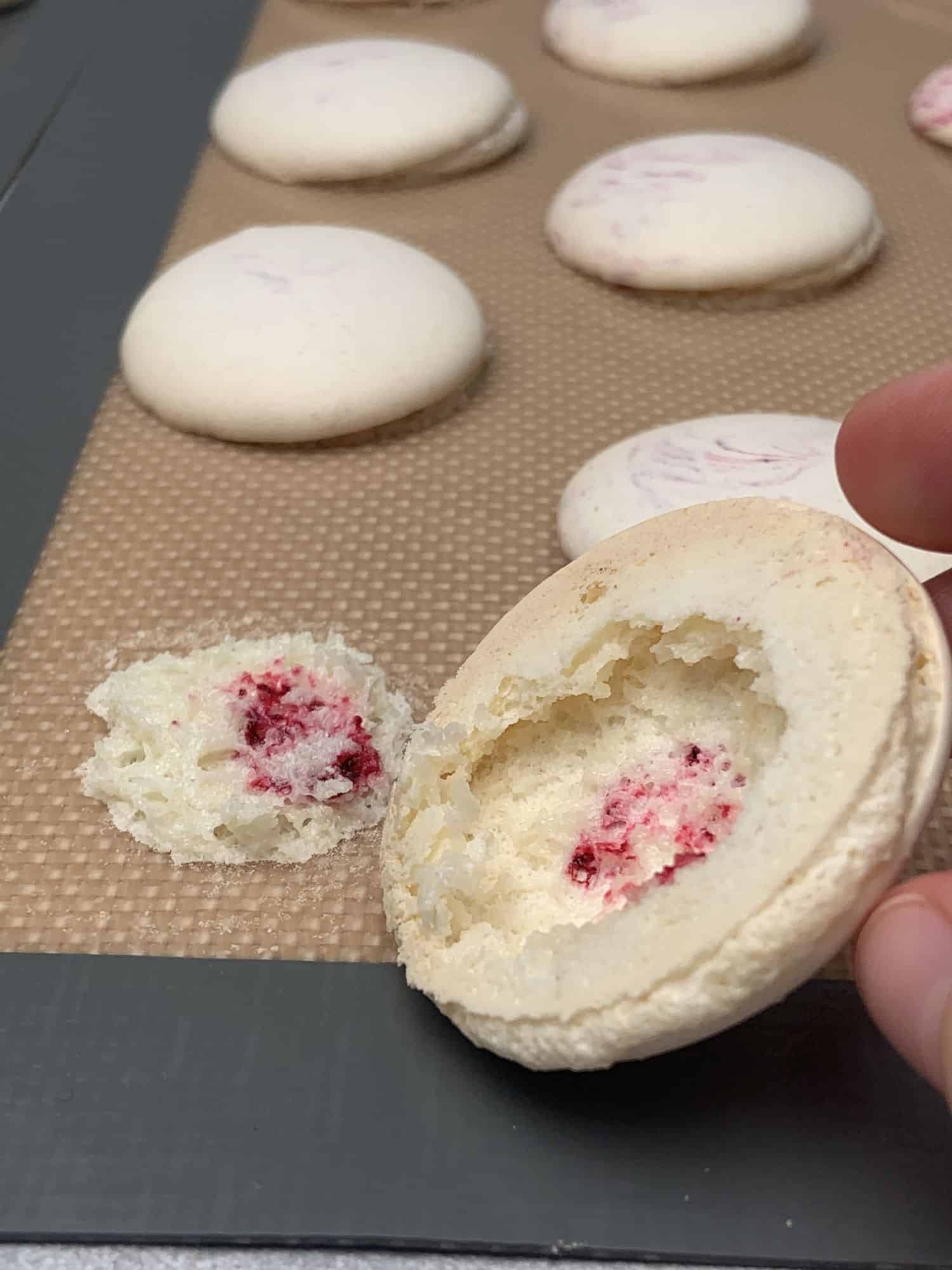
4. Macarons hollow
Possible causes & Solutions
- inappropriate macaronage - Solution: This is not an easy issue to fix as the proper folding technique comes with experience. Make sure you press some air out of the meringue as you fold it with the almond paste, which can help to avoid hollow shells
- too low oven temp - Solution: If you also experience longer than normal baking time then maybe you can increase oven temp by 5C / 50F next time
- inappropriate meringue - Solution: This again will come with experience. You have to make sure you beat the meringue just until the early stiff peak. Both under whipped and over whipped meringue can cause hollow macarons

5. Macarons have nipples
Possible causes & Solutions
- undermixed (too thick) macaron batter - Solution: This is an easy fix, aim for the ribbon stage! After adding the last third of the meringue make sure you check the consistency of the macaron batter every few seconds. How to check when the macaron batter is ready? When you lift the spatula over the mixture the batter should fall slowly forming a ribbon. Try to write number 8 with the ribbon, once the consistency allows writing the number 8, it is very likely that your macaron batter is ready
- macarons were not tapped onto the kitchen counter - Solution: Even if your macaron batter is slightly thick you can get rid of these nipples by tapping the tray onto the kitchen counter a few times
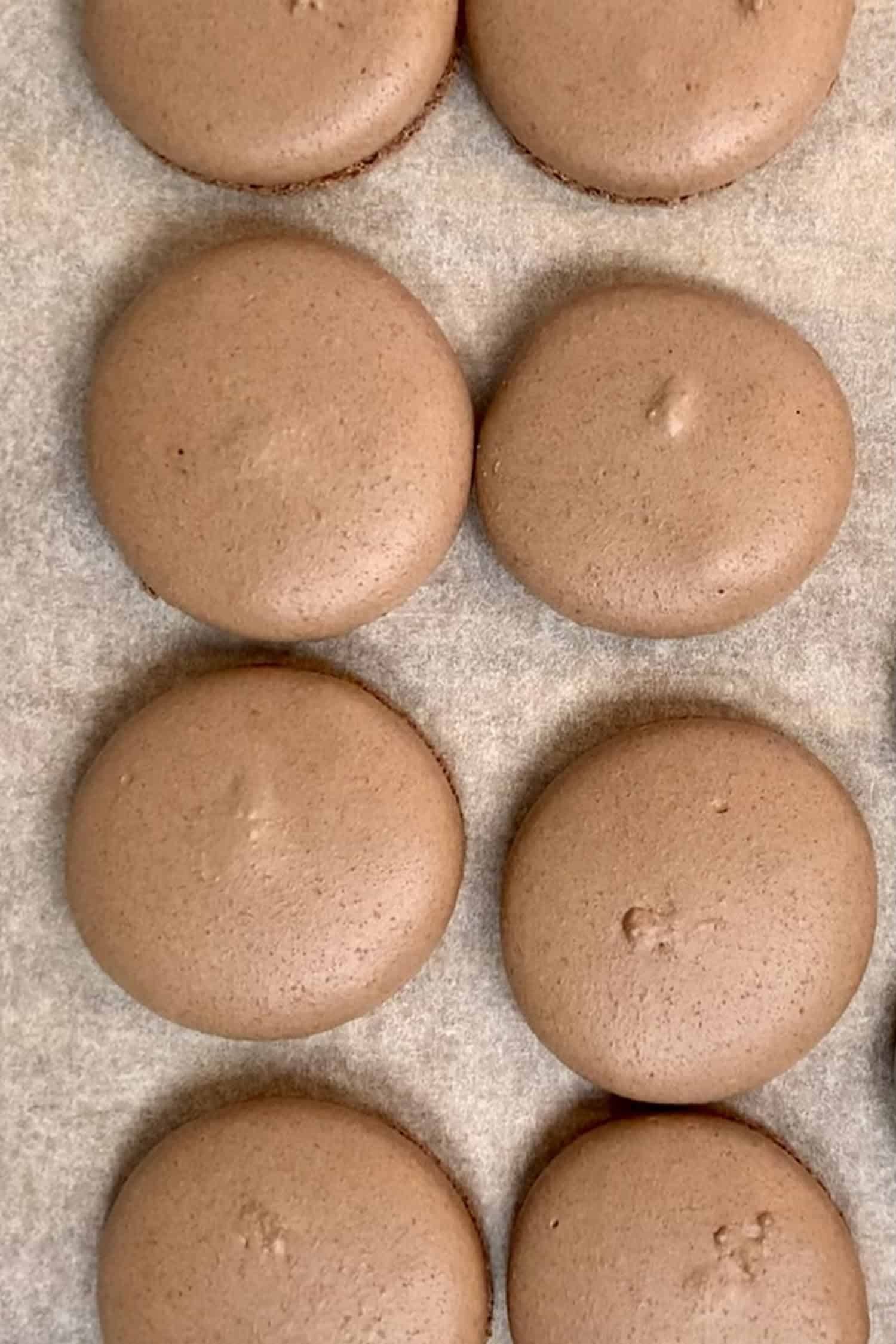
6. Macarons have no feet
Possible causes & Solutions
- inappropriate macaronage - Solution: This is not an easy issue to fix as the proper folding technique comes with experience. Make sure you press some air out of the meringue as you fold it with the almond paste, which can help to avoid a lot of troubles including no feet cookie-like looking macarons
- too low oven temp - Solution: If you also experience longer than normal baking time then maybe you can increase oven temp by 5C / 50F next time
- inappropiate meringue -Solution: This again will come with experience. You have to make sure you beat the meringue just until early stiff peak
- macaron batter is too wet - Solution: Make sure your sugar syrup has the right temp (118-120C). Also, avoid using liquid food coloring
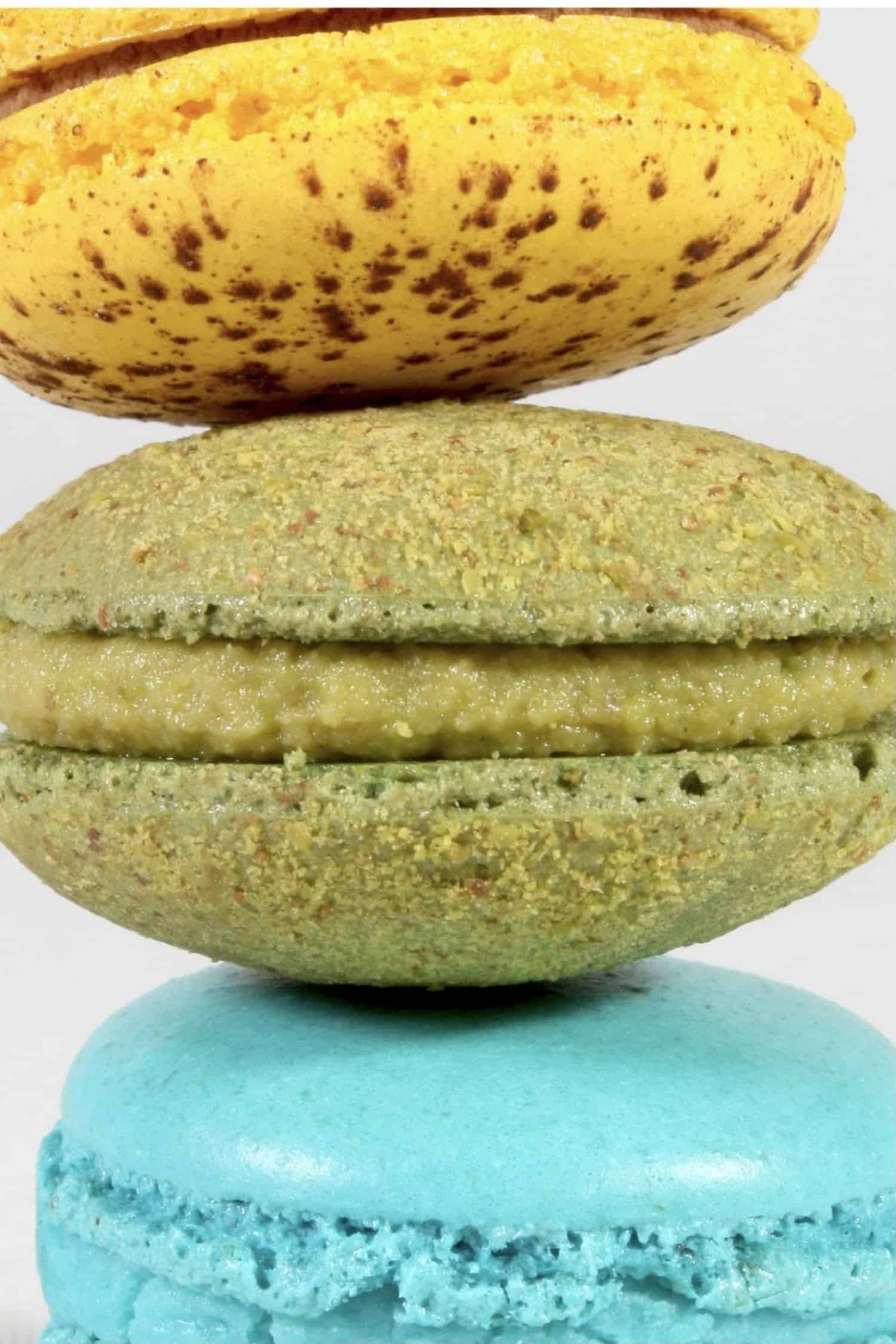
7. Macarons are flat and wrinkled
Possible causes & Solutions
- overmixed (too runny) macaron batter - Solution: Remember, aim for the ribbon stage while making this macaron recipe! After adding the last third of the meringue make sure you check the consistency of the macaron batter every few seconds. How to check when the macaron batter is ready? When you lift the spatula over the mixture the batter should fall slowly forming a ribbon. Try to write number 8 with the ribbon, once the consistency allows writing the number 8, it is very likely that your macaron batter is ready. Do not mix the macaron batter after this point as the mixture can get runny easily
- weak meringue - Solution: Make sure you aim for a strong "early stiff peak stage" meringue. If the egg white does not achieve this stage even after beating for 5 minutes in the stand mixer, it is better to start over
- too much food coloring - Solution: Avoid using liquid food coloring, or too much gel food coloring
- oily almond - Solution: Try to buy good quality blanched almond as it might get oily in the food processor while you are making it yourself
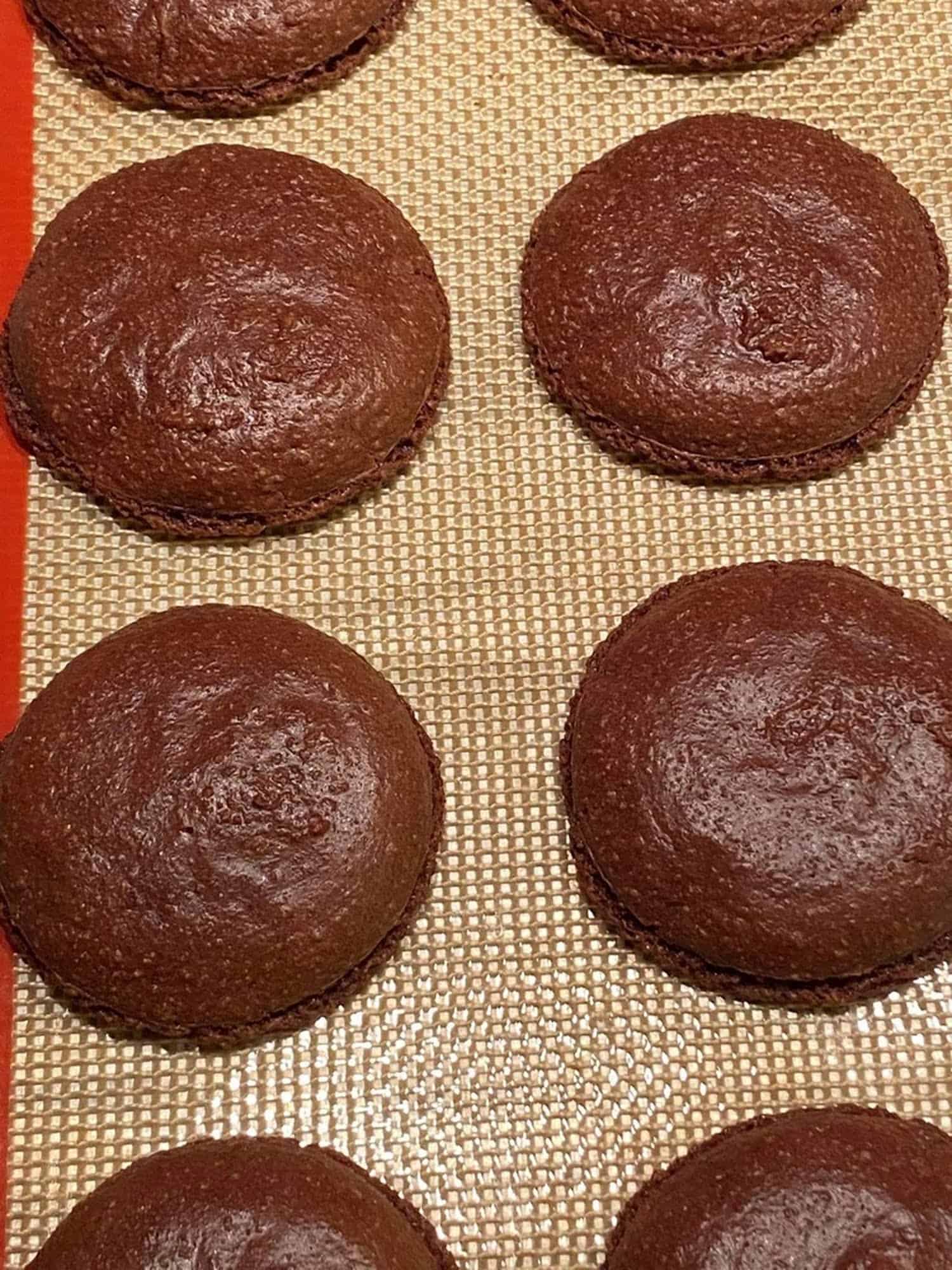
8. Macarons are browning too much
Possible causes & Solutions
- too high oven temp or baking for too long- Solution: This is an easy fix. If macarons are browning on the top, either move the tray lower and/or decrease the oven temp. If macarons are browning on the bottom, move the tray up and/or decrease the oven temp. I had an oven once that was browning my macarons so much that I actually had to place an extra tray on the top part, try this trick perhaps. Or simply bake them for less time.
9. Macarons have an uneven surfaces (bumpy and rough)
Possible causes & Solutions
- almond flour is not fine (has too large almond bits) - Solution: This is an easy fix. Pulse blend almond flour with icing sugar for 5-10 seconds (no longer as the almond can get sticky) then sift them together, in this way the almond paste will be very smooth, not bumpy
Do you experience any other macaron issues? Please let me know and I am eager to cover that too in my Macaron Troubleshooting Guide!
📢 More Macaron recipe
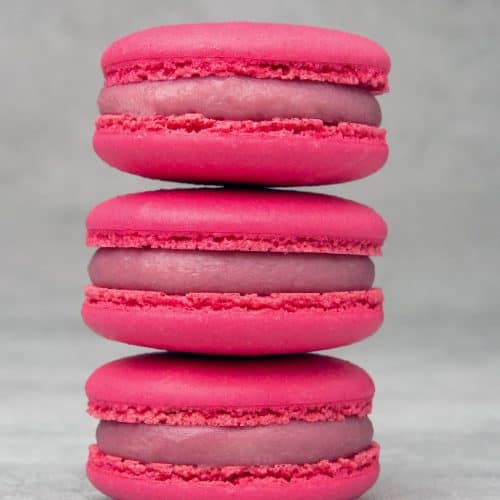
How to make macarons
Equipment
- Digital scale
- Small enough saucepan to measure sugar syrup correctly
Ingredients
Almond paste
- 150 g Almond flour finely grounded
- 150 g Icing sugar sifted
- 55 g Egg whites room temperature
Sugar syrup
- 120 g Granulated sugar
- 50 g Water
Meringue
- 55 g Egg white room temperate
- 30 g Superfine sugar
US customary cup measurement is an indicative figure only. Measure the ingredients with a digital scale by weight (gram). Baking is art but also science which requires precision and accuracy.
Instructions
- Measure all your ingredients with a Digital scale and prepare all the tools you need at hand
- Properly clean your mixing bowl and whisk attachment by wiping them down with vinegar
- Pulse blend icing sugar with almond flour for 5-10 seconds then shift them together. The mixture should be very fine powder like
- Move one of the 55g egg white into your Stand mixer
- Start making the sugar syrup by boiling granulated sugar with water in a saucepan
- Star whisking the egg white on low / medium speed then gradually add the superfine sugai into it
- Boil the sugar syrup until it reaches 118C-120C / 244-248F. Use a Infrared thermometer gun or any other thermometer to measure the correct temp
- By the time syrup reaches 118C-120C / 244-248F, the egg white & fine sugar mixture should be already reaching a consistency of somewhere between foamy and soft peak
- Once syrup on the right temp remove from heat. Keep the Stand mixer speed on medium and begin slowly pouring the syrup down on the side of the mixing bowl making sure that the syrup flows on the side only and does not get onto the whisk
- Increase Stand mixer speed to medium / high and continue whisking the meringue until it forms early stiff peaks meaning it is strong enough to hold its shape but not over whipped
- In the meantime mix the remaining 55g egg white into the almond flour mixture (almond meal & icing sugar) until it forms a paste, use a flexible Rubber spatula.
- When meringue is almost done mix in food coloring (powder or gel) and continue beating for a few more seconds
- Once meringue as well as almond paste is ready, gently fold in meringue into the marzipan paste with the help of a Rubber spatula. Fold meringue in thirds, making sure that each third is fully incorporated before adding the next
- The first third is about loosening up the marzipan, the second third already working on the macaronage process and somewhat pressing the air out and the last third is fine tuning the consistency to the stage you need that is ribbon stage
- After adding the last third of the meringue make sure you check the consistency of the macaron batter every few seconds. When you lift the Rubber spatula over the mixture the batter should fall slowly forming a ribbon. Try to write number 8 with the ribbon, once the consistency allows to write the number 8, it is very likely that your macaron batter is ready
- Move macaron batter into a Piping bag fitted with round nozzle tip and while holding the piping bag fully vertical pipe equal sized round shapes, leaving enough space in between them to slightly spread. You can pipe on Silicone baking mat or parchment paper
- Tap the baking tray onto the kitchen counter a few times to release any air bubbles. You can also pop air bubbles out using a toothpick
- Rest the macarons on room temp for about 25-40 minutes depending on temperature and humidy. Test by gently touching the macarons, it should feel dry on the touch and proper skin should form on the surface of them
- Pre-heat oven while macarons are drying. I recommend to bake the macarons 155C / 311F but I pre-heat my oven +20C / 68F more as when I open the oven door, the temp drops. Make sure you use a Digital oven thermometer to check your real oven temp
- Bake the macarons for 14-15 minutes, adjust if necessary to your oven (use my Troubleshooting guide)
- Once macarons are done, remove them from the oven and leave them on the parchment or Silicone baking mat for 30 minutes. They are not supposed to come off the baking mat until they are properly cooled
- Once macaron shells cooled, remove them from the baking sheet. In case they ended up slightly different in their sizes, pair the similar sizes next to each other
- For filling ideas read my blog post above this recipe
- Pipe filling onto one side of the macaron then press two shells together evenly so the filling will come out to the side
- Macarons require about 12h aging time in the fridge, within this time frame the filling will soften the shells.

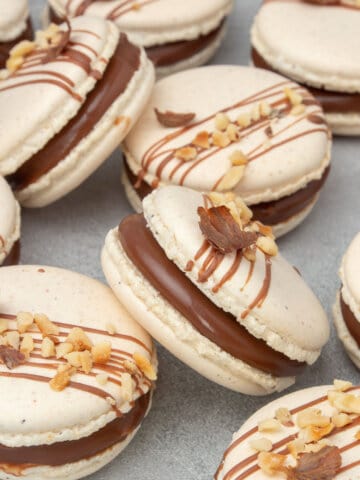
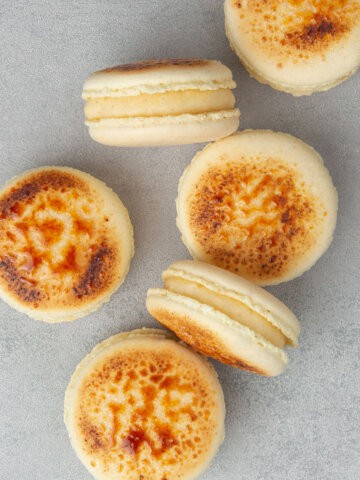
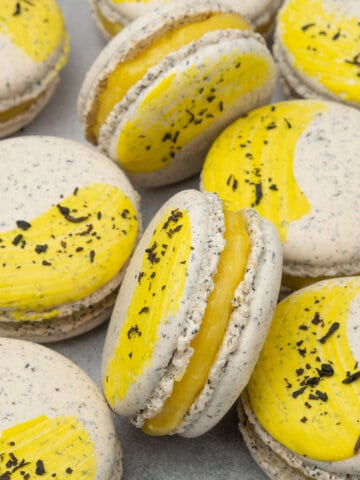
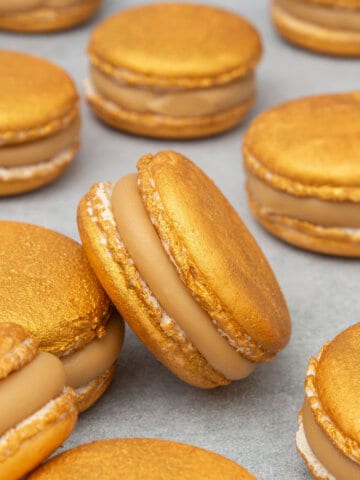


Adria Nickerson
I feel this type of cookie is not worth the amount of work one has to do to create a cookie that really doesn't taste worth it. I love baking cookies and sweets and whenever I see these (no matter how perfect they look) I will pass them by.
Katalin Nagy
Adria, if you have not tried this recipe and not even aware of that that they are not cookies, but macarons, there is really no need to leave a comment. This is a comprehensive recipe that took me years to perfect and it is written FOR PEOPLE WHO WANT TO BAKE MACARONS. I have several cookie recipes that might be more appropriate for you to read and try.
nazma
hi how to half this recipe???
Kata
Simply half all ingredients however as mentioned in the recipe, you might find it difficult to measure the sugar syrup temp bec the syrup will be such a tiny amount.
Raudha
Hi there, I did the macron recipe and there was an issue which is the top of the macron collapse and there is an empty hollow. this is my first time and am really sad that went wrong): if I can send you the pictures that would be great
Kata
You can reach me on my Instagram, but also please check my Troubleshooting guide as this is in fact a very common issue. Also don´t be too hard on yourself, making macarons requires usually more than one try:)
Luise
Baking classes costing $$$ can’t top this recipe! This is the BEST, and finally I am able to make macarons! Thank you so much I am forever grateful
Laura
It’s true this is literally the only French macaron recipe you will ever need! Thank you Katalin
Hannah Baker
What a fab recipe and guide! First time making macarons and they came out great. If you read the whole guide and stick to the recipe you can’t go wrong.
Ebru
Perfect recipe that minimizes the chance of making mistakes
Rose
THIS RECIPE..... for the KEEPSSSSS!!!! Loved it.
Fem Sinnesael
Top chef’s recipes from Belgium can’t tip this one,
It’s the best one I can across. Thank you 😊
Irina
This recipe is a keeper! Macarons turned out great from the first try! ❤ Just make sure you carefully read all the info ahead and prepare everything. 😊
Edina
Hi you mentioned that it's better to add powdered food color. How about adding cocoa powder instead will it work?
Kata
Cocoa powder is different from powder food colouring in terms of its fat content etc so it can´t be added without slightly reformulating the recipe.
Ingrid
Finally I learned to make macarons!!!
Subhani Salih
Professor
admin
Haha thanks 🙂